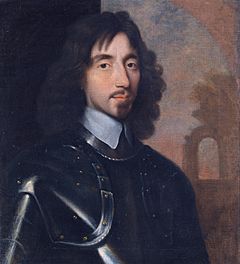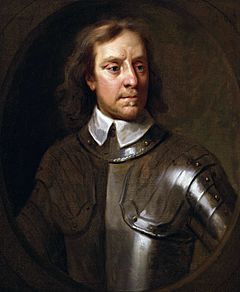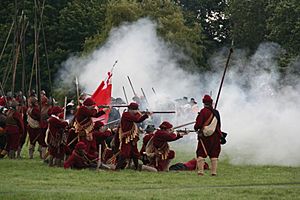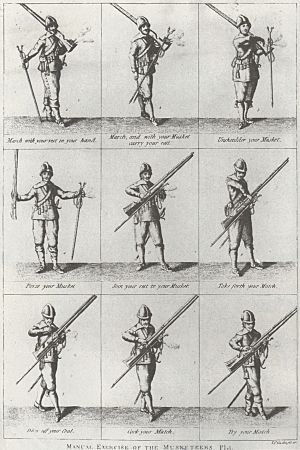New Model Army facts for kids
Quick facts for kids New Model Army |
|
|---|---|
|
The Souldiers Catechiſme: Religious justification for the New Model Army
|
|
| Active | 1645–1660 |
| Country | |
| Allegiance |
|
| Type | Army |
| Engagements | |
| Commanders | |
| Commander-in-Chief | Thomas Fairfax, George Monck |
| Notable commanders |
Oliver Cromwell, Thomas Pride, John Lambert, Henry Ireton, William Lockhart |
The New Model Army was a special army created in 1645 by the Parliamentarians during the First English Civil War. It was later disbanded in 1660. This army was different because its soldiers could be sent to fight anywhere in the country, not just in one area. To make sure the officers were professional, they were not allowed to be members of Parliament. This helped them stay focused on military tasks, away from political arguments.
Many soldiers in the New Model Army had strong religious beliefs, often from a group called Puritans. Some also had new ideas about society. Even though the top officers didn't always agree with these ideas, the army's independence from Parliament meant it played a big role in changing England. It helped to overthrow the King and set up the Commonwealth of England (1649–1660), which was a period when England was a republic.
Contents
Creating the New Model Army

Before the New Model Army, both sides in the English Civil War used part-time soldiers called Trained bands. These groups were organized by county and controlled by local leaders. They were the only permanent military force in England. However, these local troops often didn't want to fight far from their homes. This caused problems for both the Royalists and Parliamentarians.
By late 1644, Parliament realized they needed a better army. They decided to create a professional, centralized force. On February 17, 1645, the law to create the New Model Army was passed. Sir Thomas Fairfax became its commander, and Philip Skippon was made Major General of the Foot (infantry).
Around this time, some Parliamentarian commanders were not doing well in battles. Leaders like Oliver Cromwell felt that some generals lacked commitment. To fix this, a new rule called the Self-denying Ordinance was introduced. It meant that anyone holding a military command had to resign from Parliament. This removed some older, less effective commanders. Cromwell himself was an exception and was allowed to continue serving as a military leader.
How the Army Was Organized

Parliament approved an army of 22,000 soldiers. Most of these soldiers came from three existing Parliamentarian armies. The army was made up of:
- 6,600 cavalry (horseback soldiers) in eleven units.
- 14,400 foot soldiers (infantry) in twelve regiments.
- 1,000 dragoons (mounted infantry).
The New Model Army had fewer but larger regiments. This meant they needed fewer officers. Many officers from the old armies were either let go or had to take a lower rank.
Soldiers in the infantry were paid 8 pence a day, and cavalry soldiers received 2 shillings (but they had to provide their own horses). The army also improved how it provided food, clothing, and other supplies. Soldiers were also encouraged by strong religious beliefs, as shown in a book called the "Soldier's Catechism."
The Army's Name
The name "New Model Army" became popular much later, in the 1800s. In the 1600s, people usually called it the "New Modelled Army." This simply meant it was an army that had been reorganized and improved.
Dress, Equipment, and Fighting Styles
Cavalry (Horse)
The best fighters in the New Model Army were its cavalry regiments. They were armed as "harquebusiers," meaning they were lighter than heavily armored knights. They wore a metal breastplate and backplate over a thick leather coat, which offered some protection. They also wore a special helmet with a movable visor.
Cavalry regiments were divided into six troops, each with about 100 riders. Each troop had its own flag. In battle, a regiment usually formed two groups of three troops.
Their discipline was much better than the Royalist cavalry. Cromwell made sure his men didn't just chase a fleeing enemy. Instead, they would stay together, regroup, and attack another target. When they did pursue, they did so without stopping to loot, unlike the Royalist horsemen.
Dragoons
The New Model Army had one regiment of dragoons, led by Colonel John Okey. Dragoons were soldiers who rode horses to get around but fought on foot. They wore similar uniforms to musketeers and carried flintlock guns.
Their main job in battle was to clear enemy musketeers from in front of the main army. At the Battle of Naseby, they were used to go around the enemy cavalry. Later, in 1650, Okey's dragoons became a cavalry regiment. After that, dragoons were usually attached to other regiments as needed.
Infantry (Foot)
The infantry regiments had ten companies, mixing musketeers and pikemen. Most companies had 100 soldiers.

The infantry soldiers wore red coats. Red was chosen because the dye was the cheapest. Different regiments had different colored linings on their coats, which showed at the collar and sleeves. These colors also matched their flags.
The New Model Army usually had two musketeers for every pikeman.
- Pikemen wore helmets, breastplates, and backplates, sometimes with leg armor. They carried a long, sixteen-foot pike and a sword. Pikemen were important for protecting musketeers from cavalry attacks. They also led attacks against enemy infantry.
- Musketeers wore no armor by the end of the war. They carried a bandolier with twelve wooden containers, each holding a ball and gunpowder for their matchlock muskets. These containers were sometimes called the "Twelve Apostles." They were usually arranged in six ranks (rows). They would fire their guns in turns, with the back ranks moving forward to fire, or the front ranks moving back to reload. This allowed them to keep up a constant fire. When fighting up close, they would use their musket butts as clubs.
Artillery
The New Model Army also had artillery (cannons). The artillery was managed separately from the cavalry and infantry.
Cannons were most useful in sieges, where they would blast holes in enemy fortifications. Cromwell and his commanders often tried to storm towns quickly rather than spend a long time building trenches for cannons. The army was good at storming forts, like at the siege of Drogheda. However, they suffered heavy losses at Clonmel when they attacked a well-defended breach.
Supplies and Living Conditions
The New Model Army did not use tents at first. Soldiers stayed in houses, barns, or other buildings. Later, when fighting in less populated areas like Ireland and Scotland, they started using tents. Soldiers carried seven days' worth of food, usually just biscuit and cheese.
Civil War Campaigns
The New Model Army began fighting in April or May 1645. They helped lift the siege of Taunton and then marched north. On June 14, they completely defeated King Charles's army at the Battle of Naseby. After this, Fairfax led the army into the west of England, where they destroyed the last Royalist field army at Battle of Langport on July 10. They then captured Royalist strongholds across England. The war ended in early 1646 when King Charles surrendered.
Soldiers' Rights and the "Agreement of the People"
After winning the First Civil War, the soldiers were unhappy with Parliament. They hadn't been paid regularly, and Parliament wanted to disband them or send them to fight in Ireland without paying them what they were owed. Also, Parliament refused to protect soldiers from being charged with crimes they committed during the war, like stealing horses for the army.
To voice their concerns, soldiers elected representatives called Agitators from each regiment. These Agitators, along with officers, formed the Army Council. In June 1647, this council sent a message to Parliament, stating their demands.
Influenced by a radical group called the Levellers, the army proposed a new constitution called the Agreement of the People. This document called for big changes, like almost all men being able to vote, fair elections every two years, religious freedom, and an end to being jailed for debt.
Because their wages weren't paid and because of political moves by King Charles I and Parliament, the army slowly marched towards London. In late 1647, the army debated these new ideas, including the "Agreement of the People."
The Second English Civil War
The army remained strong and ready when the Second English Civil War began in July 1648. The New Model Army quickly defeated Royalist uprisings in England and Wales. They then crushed a Scottish invasion force at the Battle of Preston in August.
Many soldiers now wanted to execute the King, calling him "Charles Stuart, that man of blood" (a man who caused much bloodshed). The army's leaders eventually agreed that they couldn't trust the King. So, they decided he had to be executed. When Parliament disagreed, Colonel Thomas Pride led an action called Pride's Purge on December 6, 1648. He removed all members of Parliament who didn't support the army's views. The remaining Parliament (the Rump Parliament) then passed laws to put Charles I on trial. He was found guilty of treason and executed on January 30, 1649.
In 1649, there were three mutinies (rebellions) within the army over pay and political demands. The army leaders dealt with these rebellions, sometimes harshly, to keep control.
Campaigns in Ireland
Later in 1649, on August 15, the New Model Army landed in Ireland to begin the Cromwellian conquest of Ireland. They faced tough resistance. At Kilkenny in March 1650, the defenders fought off many attacks before surrendering. Soon after, about 2,000 New Model Army soldiers died trying to attack a well-defended breach at the siege of Clonmel.
The army also faced constant attacks from Irish guerrillas called tóraithe (meaning "pursuers"), also known as "tories." Overall, about 43,000 English soldiers fought in Ireland between 1649 and 1653.
Campaigns in Scotland
In 1650, while still fighting in Ireland, part of the New Model Army was sent to Scotland. They fought against the Scottish Covenanters, who had crowned Charles II as King. Even though they were outnumbered, Cromwell led the army to big victories over the Scots at the battles of Dunbar and Inverkeithing. When Charles II led a Scottish invasion of England, the New Model Army and local forces defeated them at the Battle of Worcester. This was the last major battle of the English Civil Wars.
After the Wars: The Interregnum
In England, the New Model Army mostly acted as a police force, dealing with small rebellions. The biggest rebellion during this time was in 1655.
The army also fought in foreign wars. In 1654, England declared war on Spain. New Model Army regiments were sent to try and conquer the Spanish colony of Hispaniola in the Caribbean. They failed and many soldiers died from tropical diseases. However, they did capture the island of Jamaica.
The English troops did better in Europe, fighting in Flanders. During the Battle of the Dunes (1658), the New Model Army's red-coated soldiers, led by Sir William Lockhart, surprised both their French allies and Spanish enemies with their fierce attack on a tall sandhill.
After Cromwell died, the government he created slowly weakened, and so did the New Model Army. In 1659, it looked like different parts of the army might even fight each other. But General Monck marched his regiments from Scotland to London to ensure the capital's safety. He faced little opposition. After some riots in 1661, the New Model Army was ordered to disband. Monck's regiment, however, became part of King Charles II's new army and is known today as the Coldstream Guards.
Some of the soldiers and officers from the disbanded New Model Army were sent to Portugal. They helped Portugal regain its independence after many years of Spanish rule. The British brigade, with 3,000 soldiers, arrived in Portugal in 1662 and played a key role in defeating the Spanish at the Battle of Ameixial in 1663.
See also
- Robert Blake (admiral) for developments in the Navy at the time
- British military history





